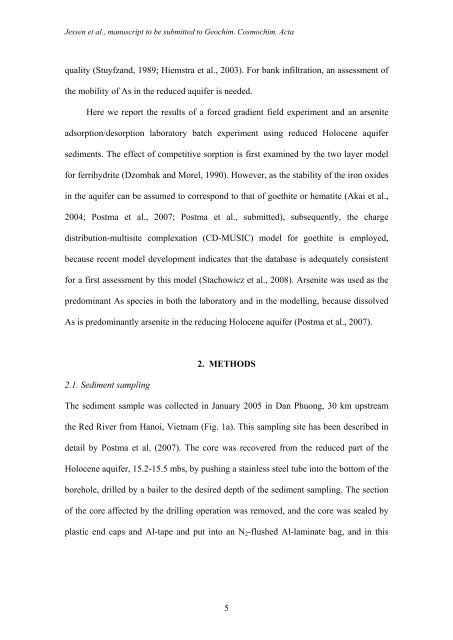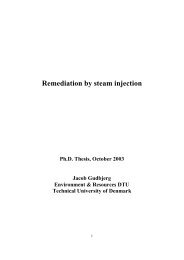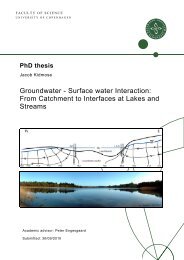Groundwater arsenic in the Red River delta, Vietnam ... - Fiva
Groundwater arsenic in the Red River delta, Vietnam ... - Fiva
Groundwater arsenic in the Red River delta, Vietnam ... - Fiva
You also want an ePaper? Increase the reach of your titles
YUMPU automatically turns print PDFs into web optimized ePapers that Google loves.
Jessen et al., manuscript to be submitted to Geochim. Cosmochim. Acta<br />
quality (Stuyfzand, 1989; Hiemstra et al., 2003). For bank <strong>in</strong>filtration, an assessment of<br />
<strong>the</strong> mobility of As <strong>in</strong> <strong>the</strong> reduced aquifer is needed.<br />
Here we report <strong>the</strong> results of a forced gradient field experiment and an arsenite<br />
adsorption/desorption laboratory batch experiment us<strong>in</strong>g reduced Holocene aquifer<br />
sediments. The effect of competitive sorption is first exam<strong>in</strong>ed by <strong>the</strong> two layer model<br />
for ferrihydrite (Dzombak and Morel, 1990). However, as <strong>the</strong> stability of <strong>the</strong> iron oxides<br />
<strong>in</strong> <strong>the</strong> aquifer can be assumed to correspond to that of goethite or hematite (Akai et al.,<br />
2004; Postma et al., 2007; Postma et al., submitted), subsequently, <strong>the</strong> charge<br />
distribution-multisite complexation (CD-MUSIC) model for goethite is employed,<br />
because recent model development <strong>in</strong>dicates that <strong>the</strong> database is adequately consistent<br />
for a first assessment by this model (Stachowicz et al., 2008). Arsenite was used as <strong>the</strong><br />
predom<strong>in</strong>ant As species <strong>in</strong> both <strong>the</strong> laboratory and <strong>in</strong> <strong>the</strong> modell<strong>in</strong>g, because dissolved<br />
As is predom<strong>in</strong>antly arsenite <strong>in</strong> <strong>the</strong> reduc<strong>in</strong>g Holocene aquifer (Postma et al., 2007).<br />
2.1. Sediment sampl<strong>in</strong>g<br />
2. METHODS<br />
The sediment sample was collected <strong>in</strong> January 2005 <strong>in</strong> Dan Phuong, 30 km upstream<br />
<strong>the</strong> <strong>Red</strong> <strong>River</strong> from Hanoi, <strong>Vietnam</strong> (Fig. 1a). This sampl<strong>in</strong>g site has been described <strong>in</strong><br />
detail by Postma et al. (2007). The core was recovered from <strong>the</strong> reduced part of <strong>the</strong><br />
Holocene aquifer, 15.2-15.5 mbs, by push<strong>in</strong>g a sta<strong>in</strong>less steel tube <strong>in</strong>to <strong>the</strong> bottom of <strong>the</strong><br />
borehole, drilled by a bailer to <strong>the</strong> desired depth of <strong>the</strong> sediment sampl<strong>in</strong>g. The section<br />
of <strong>the</strong> core affected by <strong>the</strong> drill<strong>in</strong>g operation was removed, and <strong>the</strong> core was sealed by<br />
plastic end caps and Al-tape and put <strong>in</strong>to an N2-flushed Al-lam<strong>in</strong>ate bag, and <strong>in</strong> this<br />
5





